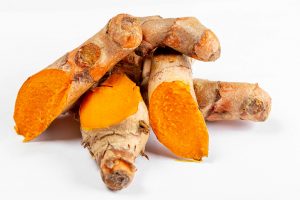
We all know about ground turmeric, besar in Nepali and haldi in Hindi, simply because it is a mainstay of Nepali as well as Indian cookery. Needless to say, the vivid orange coloured condiment adds colour to curries and pickle–but did you know it has a distinct flavour and aroma?
Some say this aromatic herb is ‘gingery bitter’; others claim it has a sharp ‘earthy, gingery flavour’. To speak about its aroma, gastronomes assert that it is ‘citrusy and mustard-like’. One thing is, however, undeniable that it is closely related to ginger as, botanically, turmeric belongs to the same family.
Surprisingly, other than adding colour and flavour to foods, turmeric is used in varied products such as biscuits, canned beverages, dairy products, bakery, sauces, curry powder, and for dyeing purposes too. Lately, the growing trend is to add it to smoothies, energy juices, and food supplements.
Have you heard about the trendsetting ‘turmeric latte’, the latest vogue across the globe? Hyped up as a healing drink, Instagram has taken it to newer heights. It is simply a milk drink blended with turmeric, also called the “golden” milk. It’s synonymous with the common practice of drinking ‘haldi-dudh’ (milk blended with turmeric) at bedtime in India.
It’s no secret that turmeric has an ancient history of being used as a medicinal herb with healing properties, both in Nepali and Indian traditions. You must have tried the piping hot turmeric, ginger and salt concoction untold times when suffering from a miserable cold.
I still remember my mom administering a paste of turmeric and mustard oil down the gullet of a sick chicken when I was a kid. Curiously, the rooster with the drooping head was clucking and cock-a-doodle-dooing in a matter of days. So did the paste work on humans when applied to cuts and wounds in rural areas where proper ointments were hard to come by.
From the time immemorial, Ayurveda has vouched for turmeric’s healing powers. The ‘science of life’ (Ayur=life, Veda=science), claims that turmeric helps balance the three energetic forces of nature: theVata (wind energy), Pitta (fire energy) and Kapha (water energy), collectively called the Doshas. From a simple cold to digestion, asthma to anemia and from diabetes, cholesterol to even cancer prevention and management, turmeric helps as a healing force.
Botanically, turmeric is called ‘curuma longa’ and belongs to the ‘Zingiberaceae’ family of herbaceous perennial plants such as ginger and cardamom. The dried, thick rhizome (stem) of Curcuma longa is called turmeric, and if looks were to go by, it can easily be mistaken for ginger. Turmeric prospers in the tropical and subtropical areas and is native to the Indian Subcontinent and Southeast Asia. The turmeric plants grow up to three feet in height and bear flowers too.
You must have heard about ‘haldi rasam’ (turmeric ceremony) in Hindu marriages in India and watched it for the umpteen times in Hindi movies and soap operas. The marriage ritual calls for this ceremony of scrubbing of the turmeric paste on the bride and groom’s body, face and feet prior to getting tied into wedlock.
The secret behind the goodness of turmeric lies in ‘curcumin’, the naturally occurring potent ingredient found in turmeric, which is said to work as an anti-inflammatory agent. Scientists assert that it’s as effective, if not more, as the Ibuprofen drugs. The percentage of curcumin in the turmeric roots is, however, very low (said to be only 2 to 5 percent in a single plant root), and a very large amount of it is required to exploit the full benefits.
Apart from its anti-inflammatory properties that help alleviate asthma, colitis, Crohn’s disease or IBD (chronic inflammatory bowel disease) amongst others, turmeric also aids in controlling and managing some serious maladies. Let’s take a look at them.

Diabetes
Scientific research is said to have found that the regular consumption of turmeric can help regulate and stabilise blood sugar spikes. The curcumin in turmeric promotes the pancreas to produce more insulin and boosts the absorption of glucose and alleviate insulin resistance. The anti-inflammatory properties of turmeric also help check the anti insulin-producing blood cells from proliferating. Both, Type I and type II diabetics can benefit from the intake of turmeric. Placebo experiments carried on pre-diabetics are said to have prevented the patients from progressing into full-blown diabetes.
Cancer
Observations and studies made on patients with advanced pancreatic, esophageal, breast and colon cancers were said to have promising results after administered with turmeric. In some of the cases of pancreatic cancer, patients showed signs of cancer regression too.
In another case of esophageal, breast and colon cancers, the antioxidant properties of curcumin in turmeric aided to disable the malignant cells, reverse their growth from spreading out and even induced apoptosis or destroyed the mutated cancer cells.
Although placebo trials made on humans and lab-experiments carried on rats have shown positive results on the management and prevention of certain cancers, the effectiveness of curcumin is still awaiting peer-reviews and scientific corroboration.
Cholesterol and heart health
Recent years have witnessed a massive escalation in the cases of cardiovascular complications in the wake of people more prone to eating an unhealthy diet, living a high-stress life (more in urban areas) and leading a sedentary lifestyle. This has invited life-threatening diseases like stroke and heart attack, a major cause of mortality worldwide. WHO (World Health Organization) estimates death figures from CVD (cardiovascular disease) at 24 million by the year 2030.
Scientific studies carried on rats fed with high-fat diet by administering a certain dosage of curcumin for a week significantly cut down the triglyceride and LDL level in their bodies. The studies report that intake of turmeric on a regular basis helps regulate the cholesterol levels, checks the oxidation of LDL and supports the function of the lining of blood vessels called endothelium.
Arthritis
Traditionally, turmeric has been used for ages in Ayurvedic medicine for treating rheumatoid arthritis. Scientists have been studying the antioxidant and antiinflammatory property found in turmeric and its possible effectiveness in the treatment of arthritis.
Pilot studies have shown that turmeric has been more effective than diclofenac in reducing joint pain and swelling. Likewise, study tests made on some 45 patients with rheumatoid arthritis disclosed that curcumin worked better than the anti-inflammatory drugs, which also have serious side effects. Turmeric, on the other hand, is non-toxic and has little or no side effects.
Cognitive function
As people grow old, it is said the human brain gradually loses its cognitive capability. The mental functions decline and people become dependent and suffer from drastic behavioral changes such as memory loss, problems with speaking, writing, thinking, making decisions and disorientation. These symptoms in old age are also attributed to Alzheimer’s disease which progresses to Dementia.
In 2016, the British Journal of Nutrition made a 12-month study to examine the effectiveness of curcumin supplementation in older people and their cognitive function. Out of the two groups, the one administered with curcumin showed no decline in cognitive ability. Scientists also maintain that a bio-active compound present in the turmeric rhizome called ‘ar-turmerone’ helps the brain in self-repair and recovery of normal function.
It is also speculated that the reason behind the significantly lower rate of Alzheimer’s disease amongst the Asian people could possibly relate to the high consumption of turmeric in their diets.
There is so much more to the amazing health benefits of turmeric that the list never seems to cease. Research scientists also substantiate: turmeric contains powerful antioxidants that destroy malicious free radicals in our bodies; it can substitute as an anti-depressant sans the side effects the prescription drugs; it works for the treatment of IBD (Inflammatory Bowel Disease); supports anti-aging, gum disease, kidney problems, diarrhea, and you name it.
Point to note
Clinical trials of turmeric have shown that even high doses of curcumin in turmeric are safe to ingest. The downside is that curcumin is not easily absorbed by our body. The best results from the intake of turmeric can be had if it is taken with black pepper.
The piperine in black pepper boosts the bioavailability of curcumin in turmeric by as high as 200 percent, thus, allowing the benefits of curcumin to be fully absorbed. Simply put, if you plan to take turmeric neat as a supplement, say a teaspoon add a tiny pinch of fresh-ground black pepper.
To sum up, the health benefits of turmeric speak for themselves. Little wonder, this golden spice has become the most sought-after so-called ‘superfood’ in the West. A company of beverage-architects called the Flavorman from Louisville, Kentucky USA, declared turmeric the top trending flavor in its yearly forecast for 2017.
Caveat
Generally considered as very safe and non-toxic, caution, however, should be taken while ingesting turmeric on a regular basis for individuals: *with bleeding disorders *iron deficiency and *pregnant women.
Disclaimer: The views expressed in the above text are solely research-based. Cross-reference and readers’ discretion is solicited. It is further suggested individuals seek medical advice or professional help, if needed.




















